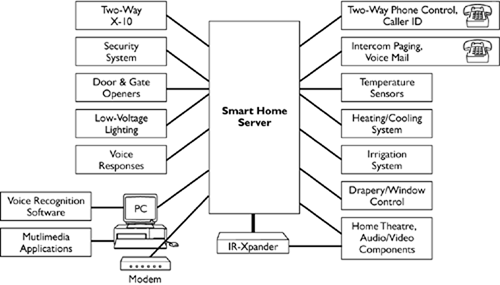AUTONOMIC COMPUTING BEYOND THE IT INDUSTRY The ultimate scope of autonomic computing will go beyond just the IT industry. The technology of autonomic computing is based around sensors. The prospect of expanding this to other areas—particularly the consumer market—is enticing. Sensors are a concept that has been accepted for some time. Once sensors are placed in everything, computing will truly be pervasive. Everything from cell phone to refrigerators and toasters, the clothes we wear, the cars we drive, and shopping malls that will pick up your preferences as you enter will be available to the consumer. Nor are these the only possibilities. Smart homes are already a market with products and software services. A smart or intelligent home uses readily available devices, many of which are currently used in home security systems, such as: -
passive infrared sensors -
pressure pads -
magnetic reed switches This could expand with the installation of a home-based server installed in the basement of a home—near the furnace, water heater, or air-conditioning. This server would perform functions such as polling all the sensors throughout the house—in the refrigerator, say, to order milk, eggs, and cheese automatically when needed. It would turn the house lights on or off, inside or out, as required. It would sense when a new movie is available that meets the needs of the family and download for viewing. Sensors could be placed in the roof of the house—if a leak is detected, the server would automatically locate the nearest repair specialist. Another use would be to sense when the roof needed painting and contact the local painters for a quote. Smart homes have the potential to enable elderly and disabled people to lead independent lives in their own homes. However, the devices and their interactions need to be chosen and designed in such a way that the system as a whole meets the very specific needs of the householder. The list is almost endless, as is indicated by Figure 16.4. Figure 16.4. A smart home server could have thousands of sensors installed all over the house. 
If your local library is technologically efficient, you can already go online to reserve books. But when those books are due to be returned, it may be a different matter. One approach to solving this problem would be to install sensors in the books themselves. The sensors could then send a wireless message to your personal computer indicating when the book should be returned. It can also help locate lost books—perhaps by sending out an audible alarm to help locate the book on your bookshelf. We are already seeing examples of this technology on the highways. Car owners can purchase prepaid sensors that sit on the windshield or the dashboard of a car. The tollbooths sense and recognize the car approaching then process and deduct the fee from the sensor. The cars no longer have to stop to proceed through tollbooths. Current tests indicate that few cars go slower than 65 miles per hour, and one unit can handle 330,000 vehicles a day. Traffic volume is on the rise everywhere in the United States. The Federal Highway Administration (FHA) forecasts that by the year 2005 there will be 50 percent more vehicles on the road than in 1990.[2] We need more automated methods to manage our highways. This technology has enormous applications both commercially and in industry. In the retail industry, large companies are already beginning to test the technology with smart shelves. Some retail stores plan to install specially designed shelves that can read radio frequency waves emitted by sensors. The shelves can scan the contents of the shelves and, via computer, alert store employees when supplies are running low or when theft is detected. This makes reordering an on demand process. Privacy advocates are worried about the ramifications of embedding tiny sensors in all kinds of personal items. Corporations could use the technology to keep consumer belongings under surveillance not only in stores, but also in their homes and on the street. Imagine, for instance, walking down the sidewalk and having a high-tech billboard flash an ad for ketchup at you because it recognized the package of hotdogs in your bag. This scenario—not unlike a scene in the sci-fi film Minority Report—is already technically feasible and in operation. Grocery retailer Safeway is testing new in-store shopping cart technology that traces shoppers' steps through its stores and flashes personalized ads at them while they're shopping. Pop-up ads are no longer limited to the Internet. Sensor Conclusions Sensor products provide accurate measurement of temperatures in production processes that include chemicals, food, beverages, petroleum, paper, minerals, metals, plastics, rubber, photographs, and pharmaceuticals. Key sectors where sensors are used include the automotive industry, process industries, industrial automation, machinery/equipment, building automation/HVAC, aerospace/defense, medicine, and consumer products. The auto industry is a major user and growth driver for the sensors industry; and process industries also significantly impact this industry. During the next five years, sensors will find key growth opportunities in high-volume consumer applications and in other core areas, such as process monitoring, control and defense, security, and space industries. Lower-priced, robust, and compact sensors with customer-centric packaging and electronics have potential to impact various types of consumer products or office automation products. The key to the proliferation of electronic sensors in the smart home and its appliances is to provide very inexpensive sensors that can work effectively with standard server technology. In addition, with the development of standard wireless communication protocols optimized for sensors, wireless sensor networks are expected to gain acceptance. Momentum is gaining in such applications as machinery health monitoring and predictive maintenance, homeland security, asset management, food monitoring, environmental monitoring, power supplies, utilities, test and development, process monitoring, and medical instrumentation. |